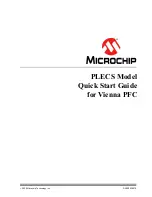Enhanced Serial Communication Interface (eSCI)
Freescale Semiconductor
26-45
PXR40 Microcontroller Reference Manual, Rev. 1
26.4.6.3.1
CPU Controlled LIN TX Frame generation
In this mode, the application initiates the generation of an LIN TX Frame and provides the data to be
transmitted by a sequence of subsequent CPU write accesses to the
LIN Transmit Register (eSCI_LTR)
.
When the eSCI module has processed the data written into
LIN Transmit Register (eSCI_LTR)
Interrupt Flag and Status Register 2 (eSCI_IFSR2)
The application should clear the TXRDY interrupt flag
before
writing data into the
because the eSCI module will set the TXRDY one clock cycle after the write access.
The first data written to the
LIN Transmit Register (eSCI_LTR)
provides the Identifier and Identifier Parity
fields. The second data written defines the number of data bytes to be transmitted. The third data written
defines the CRC and checksum generation. The TD bit has to set to 1 in order to invoke the LIN TX frame
generation. The value of the TO field is ignored by the eSCI module for LIN TX frames.
After the third data was written the generation of a LIN TX frame is started. Firstly, a break field is
transmitted, then the synch field and the protected identifier field.
All subsequent write accesses to the
LIN Transmit Register (eSCI_LTR)
transmitted via the LIN bus. A data byte field will be transmitted as soon as data are available. After the
last data byte, defined by the value written to the LEN field, was send out, the configured CRC and
checksum fields will be send out.
After the transmission of the checksum field of the LIN TX frame, the write access counter for the
is reset and the FRC interrupt flag in the
Interrupt Flag and Status Register
is set.
26.4.6.3.2
DMA Controlled LIN TX Frame generation
In this mode, the eSCI module controls the generation of an LIN TX Frame. When new data required for
transmission, the eSCI module generates the transmit DMA request and the DMA controller delivers the
required data. The application request the eSCI module to enter this mode by setting the TXDMA bit in
the
. From this point in time, the module start the generation of DMA
requests and initiates the frame transmission. Before entering this mode, the application should perform
the following actions:
1. Configure the module for LIN mode.
2. Enable the transmitter by setting TE in
3. Setup the DMA controller channel and provide frame data in system memory
A block diagram which presents an overview of the DMA Controlled LIN TX Frame is shown in
. The content of the fields in the memory is the same as described in
Summary of Contents for PXR4030
Page 1: ...PXR40 Microcontroller Reference Manual Devices Supported PXR4030 PXR4040 PXR40RM Rev 1 06 2011...
Page 30: ...PXR40 Microcontroller Reference Manual Rev 1 Freescale Semiconductor xxx...
Page 40: ...PXR40 Microcontroller Reference Manual Rev 1 xl Freescale Semiconductor...
Page 66: ...Memory Map PXR40 Microcontroller Reference Manual Rev 1 2 4 Freescale Semiconductor...
Page 120: ...Signal Descriptions 3 54 Freescale Semiconductor PXR40 Microcontroller Reference Manual Rev 1...
Page 860: ...FlexCAN Module 24 50 Freescale Semiconductor PXR40 Microcontroller Reference Manual Rev 1...
Page 1167: ...Decimation Filter Freescale Semiconductor 28 53 PXR40 Microcontroller Reference Manual Rev 1...
Page 1168: ...Decimation Filter 28 54 Freescale Semiconductor PXR40 Microcontroller Reference Manual Rev 1...


















